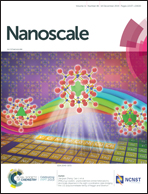Reduced SrTiO3-supported Pt–Cu alloy nanoparticles for preferential oxidation of CO in excess hydrogen†
Abstract
Activity and long-term stability of oxide–metal heterostructure catalysts can be engineered through tuning the oxygen storage capacity (OSC) of the support and careful control of the composition of the supported metal nanoparticle. In this work, we probe these two factors for microwave-synthesized PtCu alloy nanoparticles supported on reduced-SrTiO3. The heterostructures are tested for their activity towards preferential CO oxidation in the presence of H2 at typical operating temperatures used for polymer electrolyte membrane fuel cells (PEMFCs). Through controlled temperature programmed reduction/temperature programmed oxidation (TPR/TPO) experiments, we show that the OSC of the support can be enhanced through heavy surface reduction of SrTiO3. Adsorption–desorption experiments establish the strikingly different CO adsorption behavior over monometallic Pt and PtCu alloy nanoparticles. Through detailed catalytic studies, we establish a trend in the selectivity and stability of CO conversions over the PtCu alloy catalysts that can indeed be tuned by varying the PtCu composition in a facile microwave synthesis.



 Please wait while we load your content...
Please wait while we load your content...